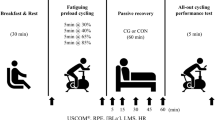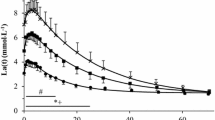Abstract
This study aimed to investigate if wearing compression stockings (CS) during exercise and recovery could affect lactate profile in sportsmen. Eight young healthy trained male subjects performed two maximal exercise tests on a cycle ergometer on two different occasions performed randomly: CS during both exercise and recovery, and no CS. Blood lactate concentration was taken during exercise and at 0, 3, 5, 10, 15, 30 and 60 min post-exercise. The individual blood lactate recovery curves were fitted to a biexponential time function: \( {\text{La}}_{(t)} = {\text{La}}_{(0)} + A_{ 1} ( 1- {\text{e}}^{{ - \gamma_{1} t}} ) + A_{ 2} ( 1- {\text{e}}^{{ - \gamma_{2} t}} ) \), where γ 1 and γ 2 denote the abilities to exchange lactate between the previously active muscles and the blood and to remove lactate from the organism, respectively. A significantly higher blood lactate value at the end of the maximal exercise was found (12.1 ± 0.5 vs. 10.8 ± 0.5 mmol l−1) wearing CS as compared to no CS (P < 0.05). Lower γ 1 and higher γ 2 values were observed with CS during recovery, as compared to no CS. It was concluded that CS during graded exercise leads to a significant higher blood lactate value at exhaustion. Since lactate exchanges were expected to be decreased during exercise due to CS, this result was likely attributable to a higher lactate accumulation related to a greater overall contribution of anaerobic glycolysis. Although the lactate removal ability was significantly improved when wearing CS during recovery, its efficacy in promoting blood lactate clearance after high-intensity exercise is limited.




Similar content being viewed by others
References
Agu O, Hamilton G, Baker D (1999) Graduated compression stockings in the prevention of venous thromboembolism. Br J Surg 86:992–1004
Allen DG, Lamb GD, Westerblad H (2008) Skeletal muscle fatigue: cellular mechanisms. Physiol Rev 88:287–332
Ashton H (1975) The effect of increased tissue pressure on blood flow. Clin Orthop Relat Res 113:15–26
Bangsbo J, Graham T, Johansen L, Saltin B (1994) Muscle lactate metabolism in recovery from intense exhaustive exercise: impact of light exercise. J Appl Physiol 77:1890–1995
Bangsbo J, Madsen K, Kiens B, Richter EA (1996) Effect of muscle acidity on muscle metabolism and fatigue during intense exercise in man. J Physiol 495:587–596
Bangsbo J, Madsen K, Kiens B, Richter EA (1997) Muscle glycogen synthesis in recovery from intense exercise in humans. Am J Physiol 273:E416–E424
Berry MJ, McMurray MG (1987) Effects of graduated compression stockings on blood lactate following an exhaustive bout of exercise. Am J Phys Med 66:121–132
Berry MJ, Bailey SP, Simpkins LS, TeWinkle JA (1990) The effects of elastic tights on the post-exercise response. Can J Sport Sci 15:244–248
Borg G (1970) Perceived exertion as an indicator of somatic stress. Scand J Rehabil Med 2:92–98
Brooks GA (1986) The lactate shuttle during exercise and recovery. Med Sci Sports Exerc 18:360–368
Brooks GA (2000) Intra- and extra-cellular lactate shuttles. Med Sci Sports Exerc 32:790–799
Chatard JC, Atlaoui D, Farjanel J, Louisy F, Rastel D, Guézennec CY (2004) Elastic stockings, performance and leg pain recovery in 63-year-old sportsmen. Eur J Appl Physiol 93:347–352
Dahn I, Lassen NA, Westling H (1967) Blood flow in human muscles during external pressure or venous stasis. Clin Sci 32:467–473
Donovan CM, Pagliassotti MJ (2000) Quantitative assessment of pathways for lactate disposal in skeletal muscle fiber types. Med Sci Sports Exerc 32:772–777
Eiken O, Bjurstedt H (1987) Dynamic exercise in man as influenced by experimental restriction of blood flow in the working muscles. Acta Physiol Scand 131:339–345
Fournier PA, Bräu L, Ferreira LD, Fairchild T, Raja G, James A, Palmer TN (2002) Glycogen resynthesis in the absence of food ingestion during recovery from moderate or high intensity physical activity: novel insights from rat and human studies. Comp Biochem Physiol A Mol Integr Physiol 133:755–763
Freund H, Zouloumian P (1981) Lactate after exercise in man. Eur J Appl Physiol Occup Physiol 46:121–176
Freund H, Oyono-Enguéllé S, Heitz A, Marbach J, Ott C, Zouloumian P, Lampert E (1986) Work rate-dependent lactate kinetics after exercise in humans. J App Physiol 61:932–939
Gill ND, Beaven CM, Cook C (2006) Effectiveness of post-match recovery strategies in rugby players. Br J Sports Med 40:260–263
Graham TE, Sinclair DG, Chapler CK (1976) Metabolic intermediates and lactate diffusion in active dog skeletal muscle. Am J Physiol 231:766–771
Hatta H (1990) Oxidative removal of lactate after strenuous exercise. Ann Physiol Anthropol 9:213–218
Hirche HJ, Hombach V, Langohr HD, Wacker U, Busse J (1975) Lactic acid permeation rate in working gastrocnemii of dogs during metabolic alkalosis and acidosis. Pflugers Arch 356:202–209
Ibegbuna V, Delis K, Nicolaides AN (1997) Effect of lightweight compression stockings on venous haemodynamics. Int Angiol 16:185–188
Juel C, Halestrap AP (1999) Lactate transport in skeletal muscle—role and regulation of the monocarboxylate transporter. J Physiol 517:633–642
Karlsson J, Bonde-Petersen F, Henriksson J, Knuttgen HG (1975) Effects of previous exercise with arms or legs on metabolism and performance in exhaustive exercise. J Appl Physiol 38:763–767
Klausen K, Knuttgen HG, Forster HV (1972) Effect of pre-existing high blood lactate concentration on maximal exercise performance. Scand J Clin Lab Invest 30:415–419
Martin NA, Zoeller RF, Robertson RJ, Lephart SM (1998) The comparative effects of sports massage, active recovery, and rest in promoting blood lactate clearance after supramaximal leg exercise. J Athl Train 33:30–35
Maton B, Thiney G, Ouchene A, Flaud P, Barthelemy P (2006) Intramuscular pressure and surface EMG in voluntary ankle dorsal flexion: Influence of elastic compressive stockings. J Electromyogr Kinesiol 16:291–302
McDermott JC, Bonen A (1992) Glyconeogenic and oxidative lactate utilization in skeletal muscle. Can J Physiol Pharmacol 70:142–149
Messonnier L, Freund H, Denis C, Féasson L, Lacour JR (2006) Effects of training on lactate kinetics parameters and their influence on short high-intensity exercise performance. Int J Sports Med 27:60–66
Messonnier L, Kristensen M, Juel C, Denis C (2007) Importance of pH regulation and lactate/H+ transport capacity for work production during supramaximal exercise in humans. J Appl Physiol 102(5):1936–1944
Monedero J, Donne B (2000) Effect of recovery interventions on lactate removal and subsequent performance. Int J Sports Med 21:593–597
Nielsen HV (1983) External pressure–blood flow relations during limb compression in man. Acta Physiol Scand 119:253–260
Nishiyasu T, Nagashima K, Nadel ER, Nadel ER, Mack GW (2000) Human cardiovascular and humoral responses to moderate muscle activation during dynamic exercise. J Appl Physiol 88:300–307
O’Donnell TF, Rosenthal DA, Callow AD, Ledig BL (1979) Effect of elastic compression on venous hemodynamics in postphlebitic limbs. JAMA 242:2766–2768
Pilegaard H, Bangsbo J, Henningsen P, Juel C, Richter EA (1995) Effect of blood flow on muscle lactate release studied in perfused rat hindlimb. Am J Physiol 269:E1044–E1051
Pilegaard H, Terzis G, Halestrap A, Juel C (1999) Distribution of the lactate/H+ transporter isoforms MCT1 and MCT4 in human skeletal muscle. Am J Physiol 276:E843–E848
Ramelet AA (2002) Compression therapy. Dermatol Surg 28:6–10
Rowell LB, Savage MV, Chambers J, Blackmon JR (1991) Cardiovascular responses to graded reductions in leg perfusion in exercising humans. Am J Physiol 261:H1545–H1553
Ryan C, Radziuk J (1994) Muscle glyconeogenesis during recovery from a prolonged swim in rats. Am J Physiol 267:E210–E218
Sahlin K, Harris RC, Nylind B, Hultman E (1976) Lactate content and pH in muscle obtained after dynamic exercise. Pflugers Arch 367:143–149
Sahlin K, Alvestrand A, Brandt R, Hultman E (1978) Acid-base balance in blood during exhaustive bicycle exercise and the following recovery period. Acta Physiol Scand 104:370–372
Stamford BA, Moffatt RJ, Weltman A, Maldonado C, Curtis M (1978) Blood lactate disappearance after supramaximal one-legged exercise. J Appl Physiol 45:244–248
Stanley WC, Gertz EW, Wisneski JA, Morris DL, Neese RA, Brooks GA (1985) Systemic lactate kinetics during graded exercise in man. Am J Physiol 249:E595–E602
Sundberg CJ, Kaijser L (1992) Effects of graded restriction of perfusion on circulation and metabolism in the working leg; quantification of a human ischaemia-model. Acta Physiol Scand 146:1–9
Thorsson O, Hemdal B, Lilja B, Westlin N (1987) The effect of external pressure on intramuscular blood flow at rest and after running. Med Sci Sports Exerc 19:469–473
Acknowledgments
The authors are grateful to all subjects participating in this study for valuable cooperation.
Author information
Authors and Affiliations
Corresponding author
Additional information
Communicated by Susan Ward.
Rights and permissions
About this article
Cite this article
Rimaud, D., Messonnier, L., Castells, J. et al. Effects of compression stockings during exercise and recovery on blood lactate kinetics. Eur J Appl Physiol 110, 425–433 (2010). https://doi.org/10.1007/s00421-010-1503-x
Accepted:
Published:
Issue Date:
DOI: https://doi.org/10.1007/s00421-010-1503-x




